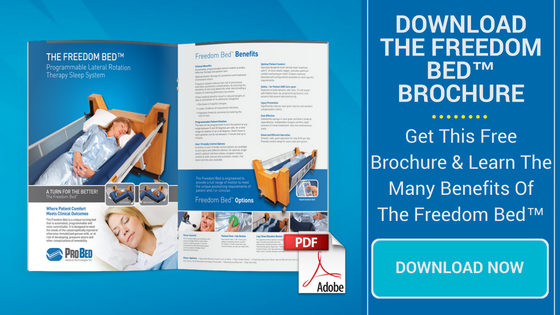ProBed Freedom BedTM - Benefits
Benefits for the Bed User
The many features of the Freedom BedTM provide a number of key benefits to immobilized bed-users such as:
- The automated turning process allows for more frequent turning to address the multi-system pathophysiological events associated with immobility. Also referred to as kinetic therapy, this turning not only provides pressure relief to prevent or treat bedsores but it can also produce, for example, a dramatic reduction in the incidence of respiratory problems and urinary tract and bladder infections
- Significantly better quality of sleep since the bed-user does not have to be manually turned during the night and is not woken up by the bed turning. This creates better mental clarity, better health and an improved lifestyle, free from dependence on caregivers during the night
- The opportunity to live in a home setting instead of an institution
- Pain reduction
- The bed can still rotate when the torso is in a raised position up to 30°. This can be added to the Reverse Trendelenburg position, if suitable, for a maximum included angle of approximately 42°. A pillow adds more elevation again. Torso elevation is of significant benefit to people who are tube fed and/or respirator dependent.
- Prevention or reduction of gastro-esophageal reflux
- Better respiratory health and clearance of upper respiratory and oral secretions
- Reduction in spasticity and abnormal tone.
- Discomfort
- Improved bowel regularity
- No dehydration and subsequent electrolyte imbalance since the bed creates no heat
Benefits for Home-Based Caregivers
The physical and mental tasks associated with caring for immobilized persons can place a considerable burden on spouses, parents, etc. The physical requirements of manually turning an immobile person frequently mean that family members become unable, through age and/or infirmity, to provide the required assistance. This results in institutionalization of the family member.
The Freedom BedTM has been designed with the caregiver very much in mind and provides considerable benefits along with the ability to provide a significantly better quality of home-based care.
The Freedom BedTM automatically turns the bed user during the night thus eliminating the need for the caregiver to get up every two hours. Sleep deprivation is considerably reduced and thus caregiver physical and mental fatigue are decreased.
There is a reduced need to manually turn or reposition the user and thus a decreased chance of the caregiver developing neck, shoulder or back injuries
The head-raising and leg-raising system and bed height adjustment assists in positioning the user for personal care and for transfer to and from a wheelchair.
Cost Benefits to the Health Care Industry
For an industry struggling to get its costs under control the Freedom BedTM offers significant savings by focusing on a strategy of prevention of the problems before they occur. It offers:
- Substantially reduced direct medical expenditures associated with repeat hospital admissions to treat pressure ulcers and other complications of immobility such as bladder and respiratory infections. It has been found that prevention of bedsores is 2.5 times less expensive than treatment - Oot-Giromini (1989)
- Support for a de-institutionalizing strategy that allows chronically immobilized patients to be moved from hospitals back to their homes (or to assisted living environments)
- Avoidance of costly readmissions from bedsores or other systemic complications
- A method to reduce the length of hospital stay for specific groups of patients. Treating critically ill patients with kinetic therapy has been shown to reduce intensive care stays by up to 24 percent. Increased movement helps reduce risk of infection and complications from pneumonia and other respiratory problems that affect about 20 percent of intensive care patients. A study in 1987 that was published in the journal “Stroke” showed that the risk of infection for stroke patients placed on normal hospital beds was 2.9 times greater when compared with a study group of patients placed on rotating beds (Stroke 18, No 3 May-June, 1987).
- Significantly reduced costs of compensation claims for nursing and support staff injured during repositioning or transferring of immobilized patients. In a study conducted for the Workers Compensation Board of British Columbia (Canada) in 1996 it was found that manual lifting, transfer or repositioning of residents (without assistance from mechanical aides) was responsible for 63% of all back, neck and shoulder injuries.
- Substantially reduced time lost by nursing and support staff from neck, back and shoulder injuries. Reduces the problems of finding replacement staff.
- Significantly reduced number of staff involved in turning patients (particularly during the night). This will reduce costs and allow staff to focus on providing a significantly higher quality of care.

